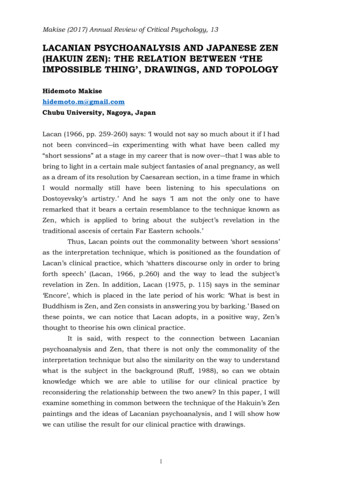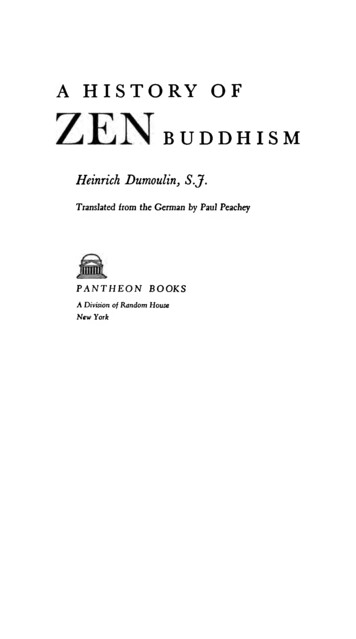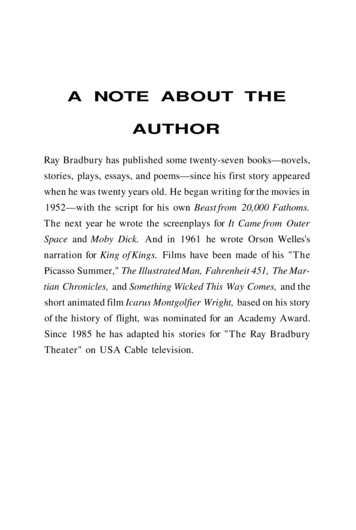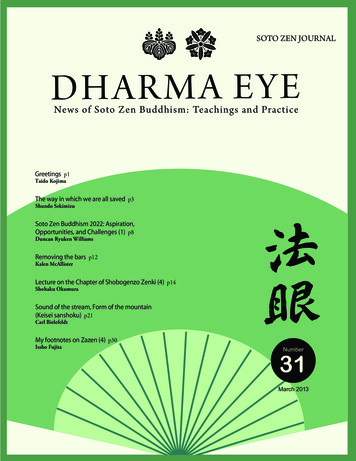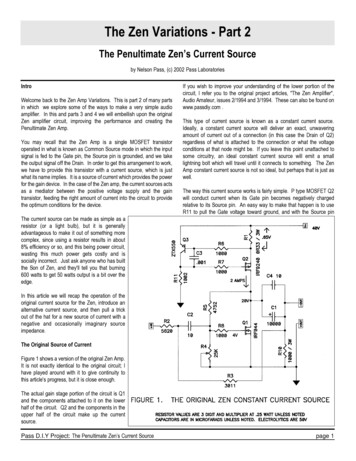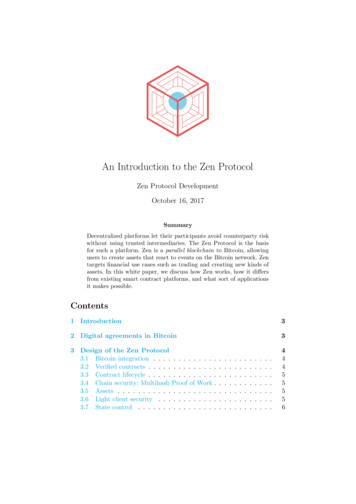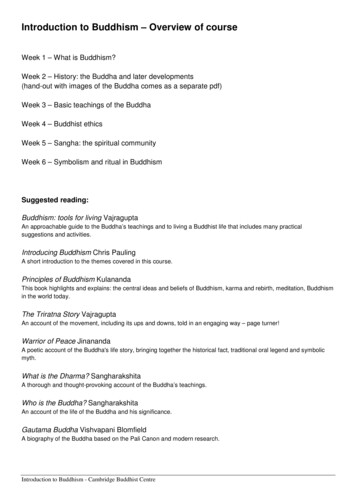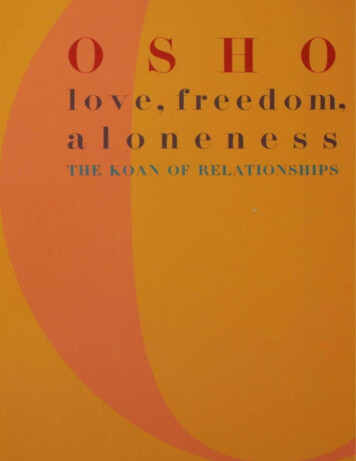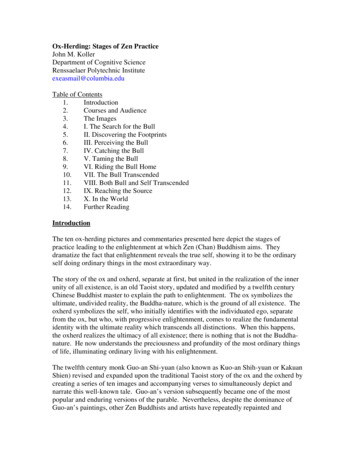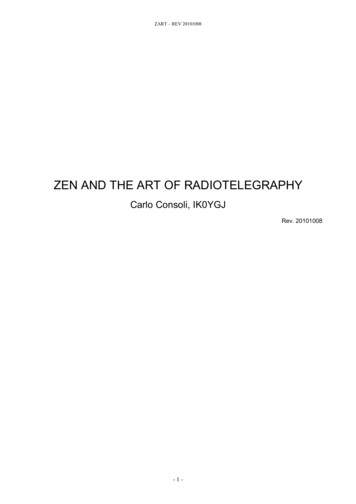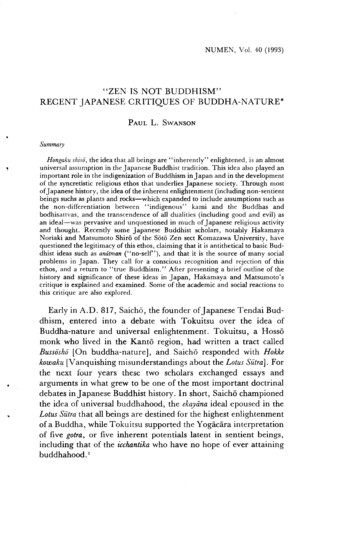
Transcription
NUMEN, Vol. 40 (1993)"ZEN IS NOT BUDDHISM"RECENT JAPANESE CRITIQUES OF BUDDHA-NATURE*PAULL.SWANSONSummaryHongaku shiso, the idea that all beings are' 'inherently" enlightened, is an almostuniversal assumption in the Japanese Buddhist tradition. This idea also played animportant role in the indigenization of Buddhism inJ apan and in the developmentof the syncretistic religious ethos that underlies Japanese society. Through mostofJapanese history, the idea of the inherent enlightenment (including non-sentientbeings suchs as plants and rocks-which expanded to include assumptions such asthe non-differentiation between "indigenous" kami and the Buddhas andbodhisattvas, and the transcendence of all dualities (including good and evil) asan ideal-was pervasive and unquestioned in much of Japanese religious activityand thought. Recently some Japanese Buddhist scholars, notably HakamayaNoriaki and Matsumoto Shiro of the Soto Zen sect Komazawa University, havequestioned the legitimacy of this ethos, claiming that it is antithetical to basic Buddhist ideas such as aniitman ("no-self '), and that it is the source of many socialproblems in Japan. They call for a conscious recognition and rejection of thisethos, and a return to "true Buddhism." After presenting a brief outline of thehistory and significance of these ideas in Japan, Hakamaya and Matsumoto'scritique is explained and examined. Some of the academic and social reactions tothis critique are also explored.Early in A.D. 817, Saicho, the founder of Japanese Tendai Buddhism, entered into a debate with Tokuitsu over the idea ofBuddha-nature and universal enlightenment. Tokuitsu, a Hossomonk who lived in the Kanto region, had written a tract calledBussoshO [On buddha-nature], and Saicho responded with Rokkekowaku [Vanquishing misunderstandings about the Lotus Sutra]. Forthe next four years these two scholars exchanged essays andarguments in what grew to be one of the most important doctrinaldebates in Japanese Buddhist history. In short, Saicho championedthe idea of universal buddhahood, the ekayiina ideal epoused in theLotus Sutra that all beings are destined for the highest enlightenmentof a Buddha, while Tokuitsu supported the Yogadira interpretationof five gotra, or five inherent potentials latent in sentient beings,including that of the icchantika who have no hope of ever attainingbuddhahood. 1
116Paul L. SwansonWhat, you might ask, does this debate have to to do with the contemporary study of religion and our understanding of Buddhism inJapan? Just this: we are in the midst of a very provocative"rethinking" of Japanese Buddhism by some prominent Buddhistscholars and thinkers who claim that Ch'an/Zen, the tathiigatagarbha ("womb of the Buddha") tradition, hongaku shZ"so ("original"or "inherent" enlightenment), and related ideas are "not Buddhism." This is tantamount to saying that most, if not all, ofJapanese Buddhism is not Buddhism at all. In a sense what they aresaying is not at all that new-the tathiigata-garbha tradition andBuddha-nature ideas have always been open to the charge that theyposit an un-Buddhist substantialist or atman-like existence, and itis akin to the debate between Saicho and Tokuitsu in our contemporary context. What is the "true" understanding of the teachingof the Buddha? Which of the many and varied strands (if any) ofBuddhist tradition should be accepted as correct and proper, andwhich (if any) should be rejected as contrary to the BuddhaDharma? What are the wider social implications of accepting orrejecting certain interpretations of the Buddhist tradition?It is usually assumed that Saicho "won" the debate againstTokuitsu, and certainly Saicho's stand of universal buddhahoodbecame the accepted presupposition for most of Japanese Buddhism, and is in fact the dominant religious ethos in Japan. Hongakush so-a way of thinking that came to include such ideas as theinherent enlightenment of all things (including non-sentient beingssuch as grasses and trees, rocks and mountains); the identity ofsarpsara and nirvaQ.a; no differentiation between the "indigenous"kami and the Buddhas and bodhisattvas; the transcendence of alldualities, including good and evil-grew to be pervasive andunquestioned in much of Japanese religious activity and thought.However, there have also been times, though few and far between,when the idea and implications of hongaku sh so were questioned.Now is such a time.The current attack is led by two Buddhist scholars at KomazawaUniversity (associated with the Soto Zen sect): Hakamaya Noriakiand Matsumoto Shiro. The main focus of their attack is the hongakushiso tradition-strictly speaking the idea that all things are"inherently" or "originally" enlightened-and the implications of"
"Zen is Not Buddhism JJ117this kind of thinking (such as the ideal ofwa, "harmony" or "conformity") that is pervasive in Japanese society. In this paper I willbriefly examine the development of this tradition in Japan, itssignificance for Japanese religion and society, and the recent critique of this tradition by Hakamaya, Matsumoto, and otherJapanese scholars.History oj Hongaku ShisaThe term hongaku [Chin. pen-chiao] has no Sanskrit equivalent,and makes its first appearance in the Awakening oj Faith, a text probably compiled in China,2 and in two Chinese apocryphal Buddhisttexts, the Jen-wang ching [T 8.825-834, 834-845)3 and the* Vajrasamiidhi-siitra [T 9.365-373].4 In the Awakening oj Faith,hongaku is used in contrast to shigaku, the "inception"or "actualization" of enlightenment, i.e. the process by which one realizesenlightenment in his life; thus the English rendering' 'original"enlightenment. The Awakening oj Faith teaches that. "original enlightenment" indicates [the essence of Mind (a priori)] in contradistinction to [the essence of Mind in] the process of actualization ofenlightenment; the process of actualization of enlightenment is none otherthan [the process of integrating] the identity with the originalenlightenment. 5This idea of original or inherent enlightenment, along with theAwakening oj Faith in general, had a great influence on the develop-ment of East Asian Buddhism. 6 Some brief examples: Fa-tsang(643-712), the Hua-yen patriarch, is also well known for hisinfluential commentary on the Awakening oj Faith;? the idea was pervasive in the Ch'an tradition; and it influenced the development ofthe concept of "the Buddha-nature in non-sentient beings" in theT'ien-t'ai tradition.In Japan hongaku thought took on a life of its own. Its influencewas felt in the Shingon school, particularly through Kukai's extensive use of the Shakumakaen-ron [T # 1668, 32.591-668], anapocryphal commentary on the Awakening oj Faith attributed toNagarjuna. The development of hongaku shisowas especially prominent in the Tendai school. After the Tendai school was transmittedto Japan by Saicha it underwent many developments, 8 one of which
118Paul L. Swansonwas the growth of an identifiably independent branch calledhongakumon. Texts devoted to hongaku shisii made their appearancein the late Heian and Kamakura periods and some were attributedto prominent Tendai figures such as Saicho, Genshin, and Ryogen.These texts include the Honri taikiJ shu, attributed to Saicho, whichinterprets the most important Tendai teachings in terms of hongakushisii; Hymns on Inherent Enlightenment [Hongaku-san], with commentary attributed to Ryogen [Chu-hongaku-san] and Genshin [Hongakusan shaku], and texts such as the Shuzen-ji ketsu, attributed in part toSaicho, which contain details on the oral transmissions (kuden) ofhongaku ideas, practices, and lineages. 9 Such oral transmissions andthe accompanying lineages were an important part of the hongakutradition.It is no accident that these developments were contemporaneouswith (even part of) the growth of the syncretistic honji-suijakulshinbutsu shugii movement, the tendency to emphasize the unity of Buddhist and "Shinto" deities and practices. Its influence can be seenin the development of Shugendo (the way of mountain asceticism),in Shinto, and in all of the Buddhist schools. Building on theMahayana idea of the "identity of sarpsara -and nirvaQa," hongakushisii developed into an ethos (to use Tamura Yoshiro's words) of"absolute non-duality" and "total affirmation" of the mundaneworld. The ideal is perhaps best expressed in the phrases siimokukokudo shikkai jiibutsu and sansen siimoku shikkai jiibutsu [the grasses,trees, mountains and rivers all attain buddhahood], phrases whichpop up almost incessently in Japanese literature, art, theatre, andso forth. 10 This religious ethos was the overwhelming status quo formost of Japanese history, and continues to dominate today despitethe attempt by the State to forcibly "separate" Buddhism andShinto elements (shinbutsu bunrz) in the early Meiji period.There have been a few exceptions to the dominance of thehongaku ethos. Noteworthy is the work of Hochibo Shoshin in the12th century, 11 Shoshin was critical of hongaku shisii, saying that oneshould not understand if to mean that sentient beings are"already" enlightened, and that such an interpretation deniescausality and is the heresy of "naturalism" (shizen gedO).12 It is often·pointed out that the so-called "new" Kamakura Buddhist schoolsarose in reaction against the hongaku stance of the Tendai establish-
"Zen is Not Buddhism))119ment, but I think that in actual practice these movements soon"reverted to" (if they had ever rejected) what Hakamaya andMatsumoto criticize as a hongaku ethos. In the Tokugawa periodMyoyu (1637-1690) and Reiku (1652-1739) of the Anraku schoolurged a revival of the keeping of the precepts based on the SsujenIii [Jpn. Shibun-ritsu] in response to what they perceived as adecadence encouraged by hongaku shiso. This movement was exceptional, however, and the hongaku ethos continues as an unquestioned assumption for much, if not all, of Japanese Buddhism.Recent Critiques of Hongaku ShisoThe current controversy concerning hongaku shiso centers aroundtwo figures associated with Komazawa University, MatsumotoShiro and Hakamaya Noriaki, but includes a number of others. Itis significant that these figures are all first-rate textual scholars andphilosophers, as well as faculty members of the Soto-Zen-affiliatedKomazawa University. Theirs are not casual criticism made byoutsiders or sloppy scholarship based on lack of familiarity with theBuddhist tradition and its texts. These are first-rate academicstudies prepared by committed Buddhists.Matsumoto Shiro, a specialist in Mahyamika Buddhism, published a collection of his essays in 1989 called Engi to kii-nyoraizoshiso hihan [Causality (pratitya-samutpiida) and emptiness (fiinyatii)A critique of tathiigata-garbha thought]. I will attempt to summarizethe main points Matsumoto makes in these essays.I. The first essay, provocatively titled" Tathiigata-garbha thought isnot Buddhism" [Nyoraizo shiso wa bukkyo ni arazu] leaves no doubtas to Matsumoto's position or intent. Tathiigata-garbha thought isnot Buddhism-then what is the correct teaching of the Buddha?Buddhism is the teaching of non-self [muga; aniitman], the teachingof causality [pratztya-samutpiida]. This teaching of causali ty is not theteaching of universal mutual co-arising and non-temporal causalitydeveloped later (e.g. by Hua-yen thinkers), but the temporal,twelvefold chain of dependent arising as discovered by the Buddhaduring his enlightenment under the Bodhi tree and classicallyexpressed in the Mahiivagga. 13 The critical point is a denial of any
120Paul L. Swansoneternal, substantial, underlying basis or locus on which everythingelse depends or arises from. This "locus" that is denied by theteaching of causality is given the name" dhatu," and any teachingthat implies the existence of a dhatu is called' 'dhatu-vada," a neoSanskritism coined by Matsumoto. Dhatu-vada is antithetical toBuddhism, since it is the very teaching that Sakyamuni intended todeny. The idea of a tathiigata-garbha, the "womb," "matrix," or"seed" of buddhahood inherent in all sentient beings, is a form ofdhatu-vada and thus is not Buddhism.Dhatu-vada is further explained using a chart: super-locusdhiltu (5tman) IocusThe "locus" (L) is the underlying basis, and the "super-locus"(S) are the phenomenal "dharmas" which arise based on the locus.The teaching of dhatu-vada follows a certain pattern:1. L is the basis for S;2. L gives rise to [is the source of] S;3. L is one, S are many;4. L is real (existent), and S are not real (non-existent);5. L is the essential nature (honshitsu; atman) of S;6. S is not ultimately real, but "participates" in reality assomething that arises based on L.The teaching of dhatu-vada appears to be a teaching of"equality" (byiidii shisii)-after all, it says that all things are basedon a single, universal, eternal reality. However, in practice it leadsto discrimination (sabetsu shisii) , because if one assumes a singlebasis and underlying reality for all things-that good and evil,strong and weak, rich and poor, right and wrong, are fundamentally "the same" -there is no need or incentive to correct anyinjustice or right any wrong. In practice, then, dhatu-viida supportsand fosters discrimination and injustice. The idea of a universal,
"Zen is Not Buddhism"121inherent buddhahood appears optimistic, but in fact enhances thestatus quo and inhibits improving the human condition.The article closes (p. 8) with a summary conclusion in threeparts:1. Tathiigata-garbha thought is a form of dhiitu-viida.2. Dhiitu-viida is the object of Siikyamuni' s criticism, and thecorrect Buddhist teaching of causality (pratitya-samutpiida) is adenial of dhatu-viida.3. Contemporary Japanese Buddhism can only claim to betruly Buddhist insofar as it denies the validity of tathiigata-garbhathought.II. The second essay, "On pratitya-samutpiida," as well as the restof Matsumoto's work, expands and gives detailed support to thebasic assertions outlined in the first essay. Here Matsumoto critiques the work of many of the most prominent modern JapaneseBuddhist scholars, such as Vi Hakuju, Watsuji Tetsuro, HirakawaAkira, Tamaki Koshiro, Fujita Kotatsu, and Tsuda Shin'ichi.Some of the more interesting points made in this long essay:There is no religion without time. The correct understanding ofcausality is not that of theoretical, spatial, or mutually inclusivecausality, but a temporal causality of an effect following after acause. The twelve-linked chain of causation refers not to the relationship between things, but the temporal sequence from cause toeffect. In terms of the locus/super-locus scheme, pratitya-samutpiidais a sequence of super-locus without a locus; a sequence of properties and not things (dharmas). There is no reality (dhiitu) beyondor underlying this temporal sequence. [pp. 14-36) This understanding of pratltya-samutpiida can be schematized as follows:
122Paul L. SwansonThe concept of hongaku (Matsumoto uses the English "originalenlightenment") posits "pre-time" or state beyond time fromwhich all things arise, or in or on which all things are simultaneously and mutually related. This is dhiitu-viida. [pp. 65-77]In a note (# 11, pp. 79-81) Matsumoto says that the dhiitu-viidaway of thinking can be found in all ancient societies regardless ofEast or West. It is the idea that "all things arise from and returnto One." If so, then it is possible to say that Tathiigata-garbhathought/dhiitu-viida is the theoretical/philosophical development of"native" (dochaku-dare I say "primitive' ') animistic ideas and"folk religion" (minzoku shukyii).14 Some claim that the idea of sansensomoku shikkai jobutsu is the climactic development of Buddhistthought, but it is only a form of animism. There is no period inhistory where animism has been held in higher esteem than today.Recently at a conference in Japan, a certain scholar claimed that"The basis of the religious consciousness of the Japanese people isanimism and ancestor veneration." This kind of understanding offolk religion and tathiigata-garbha thought is closely related. Both arethe theoretical development of "native" (dochaku) ways of thinkingand its most representative exponent is the Nihongaku("Japanism") of Umehara Takeshi. It is not at all surprising thatUmehara is a proponent of both Japanese folk religion andtathiigata-garbha thought.III. This last theme is taken up in the third essay, Bukkyo toshingi-han-nihonshugiteki kosatsu [Buddhism and the kamithoughts against "J apanism"]. Here Matsumoto criticizes the kindof easy' 'J apanism" and pro-J apan glorification represented by theNihongaku of Umehara Takeshi. He first introduces the ideas ofUmehara, who often speaks of the superiority of the Japanese race,and who presents Japanese Buddhism positively in terms of itstathiigata-garbha elements, the "buddahood" of inanimate things,and the emphasis on wa. IS He points out that ideas such as "nothought and no conceptualization" (munen musii) , "direct intuition" (chokkan) , and "non-reliance on words" (furyu monji) , thathave been introduced in the West as representative of "Zen," arein fact ideas based on tathiigata-garbha and hongaku thought, andshould not be considered positive Buddhist virtues.
"Zen is Not Buddhism"123The "Japanism" of Motoori Norinaga, Kawabata Yasunari,and Mishima Yukio are then briefly outlined, showing their closeidentification of themselves with the country or concept of"J apan." He concludes that such thinking is a "philosophy ofdeath" (shi no tetsugaku) and as a Buddhist he must reject allphilosophies of death.He concludes (p. 111):The idea that the ancient Japanese people had an optimistic attitude towardlife and this became pessimistic due to the introduction of Buddhism is a lotof rubbish put forth by people who know nothing about religion. In fact, theancient Japanese people had no basis for living with hope. They lived theirlives in this world knowing only that they must wait in fear for their inevitabledeath, and that after death they were faced with the feared land of darkness(yomi no kum). It was only through their encounter with Buddhism that theywere given hope, or in other words, given the conviction oflife (resurrection)after death.Finally, allow me to share some of my thought with regard to my personalrelationship with Japan. I believe that to love Japan is to love one's self. Tome "Japan" is an extension of my own mind and body. As I love my ownbody, so I love Japan. Self-love-narcissism-is very enticing and sweet. .However, love is something which should be directed to others; if it isdirected at one's self, it becomes self-attachment.On the basis of the Buddhist teaching of non-self (muga-setsu), I have cometo the following conclusions:1. One should disdain oneself; and2. One should love only the absolute other (God or Buddha).Therefore, as a Buddhist, based on the teaching of non-self, I must not loveJapan since it is an extension of my self.Even if I believe I should not love myself, it is certainly true that I amalways loving myself; even if! believe I should not 10veJapan, I cannot avoidloving Japan. However, the teaching of the Buddha is absolute . A Buddhist must not love Japan [i.e. one's own country].IV. The fourth essay, Jitsuzairon hihan [A critique of "existence"]'deals with Tsuda Shin'ichi's criticisms of Matsumoto's argumentsmade in chapter 2 (which had been published as an article earlier).Matsumoto makes a detailed, technical, and textual argument (pp.121-190) against understanding "dharma" as "existence," andexpands on his critique of dhatu-vada.V. In Gedatsu to nehan-kono hi-bukkyoteki naru mono [Liberation(vimuktt) and nirvaI,la-Some non- Buddhist ideas 1Matsumoto goeseven further in his critique to say thatthe final goal of Buddhism is said to be "liberation" (gedatsu; vimukti). However, in the effort to correctly understand Buddhism there is no greater
124Paul L. Swansonmisunderstanding. The reason is that the idea of liberation (vimuktl) is basedon the non-Buddhist idea that there is a self (titmavtida) [to be liberated], andis therefore an anti-Buddhist idea. Not only liberation, but also the ideas ofnirvaJ.la, a concentrated state of mind (jhtina, samtidhi), and even the idea ofa mind (citta), are all based on the non-Buddhist idea of a self. [po 191]In this essay Matsumoto leaves aside the ideas ofjhana, samadhi,and citta and concentrates on liberation and nirval)a.In short, he argues that the idea of liberation and mrval)apresupposes a "self" to be liberated, and is thus a dhatu-vada. Heargues against the prevalent interpretation of nirval)a as "extinction" -based on the etymology of nir.,jva, to "blowout" -andinstead argues for the etymology of nir.,j vr, to "uncover." Matsumoto gives a painstaking textual study to support his contention,and concludes with four points (pp. 195-219):1. The original meaning of "nirval)a" was not "extinction"but "to uncover."2. The basic idea of "nirval)a" is "the liberation of the atmanfrom that which is not atman," and is thus related to the ideaof "liberation" as the goal of Buddhism. Thus both ideas of"nirval)a" and "liberation" are based on the idea of anatman.3. The atman is often compared to "light," or it is said thatthe atman gives forth light. If one uncovers or takes away thatwhich is hindering the light, then the light can shine forth andilluminate the darkness. Thus the "extinction of light" cannotbe the meaning of a liberation or "nirval)a" of an atman.4. "The liberation of the atman from that which is not atman"is, in other words, the liberation of the "spirit" from the"body." Thus, complete liberation is possible only by completely escaping the body, and therefore this kind of liberationthought is a "philosophy of death."We have yet to see how far Matsumoto is willing to go in denyingor reinterpreting traditional Buddhist terms and concepts. As weshall see later, Takasaki Jikido takes Matsumoto to task for goingtoo far and leaving nothing that can be called "Buddhist."VI. The next essay on Hannaya-kyo to nyoraizo shiso [The Prajnaparamita Sutras and tathiigata-garbha thought] shows that although
"Zen is Not Buddhism))125the PrajiiaparamiUi Sutras began [with the A!.tasiihasrikii-prajiiiipiiramitii] as writings based on the idea of emptiness (funyatii), dhatuvada-type ideas gradually crept in and one must be careful todiscriminate the contents of the Prajiiaparamita Sutras texts.One of the main arguments here is that the earliest extant versionof the A .tasiihasrikii-prajiiii-piiramitii, the Chinese translation made in179 A.D. (Dogyo-hannya-kyo, T # 224, 8.425-478), does not containthe famous passage that the" mind is originally pure" [prakrtif cittasya prabhiisvariil, a passage used to support tathiigata-garbha-likeideas.Matsumoto concludes that the early Prajiiaparamita Sutrastaught emptiness, but gradually incorporated tathiigata-garbhatendencies, finally resulting in the compilation of theA bhisamayiilarrzkiira , an influential commentary on the Larger Prajiiiipiiramitii Sutra that embraces tathiigata-garbha ideas. Matsumotoadvocates studying early versions of the Prajiiaparamita Sutras,such as the Dogyo-hannya-kyo, to help weed out these later (andmistaken) accretions.VII. The next essay on Shiimangyo no ichij'o shiso ni tsuite [On theekayiina idea in the Srzmiiliidevz Sutra] is an early essay by Matsumoto,the arguments of which are better developed in other essays. Byexamining the tathiigata-garbha ideas in the Srzmiiliidevz Sutra Matsumoto concludes thatIndian Mahayana Buddhism is usually considered to have had two majorscholastic traditions: the Madhyamika and Yogacara. This is fine for classifying the scholastic (gakuha) traditions, and I cannot agree with the opinion thatthe tathiigata-garbha tradition was a third school. In India there were certainlyscholastic debates within the Yogacara school, and debates within theMadhyamika school, and there were also debates between the Yogacara andl\1adhyamika schools, but can it be said that there were debates between thetathiigata-garbha and the Yogacara schools? [No, I don't think so.]VIII. The final essay, Ku ni tsuite [On emptiness], discusses funyatiifrom the perspective of pratztya-samutpiida. Matsumoto argues thatthe main theme of Nagarjuna's Mulamadhyamaka-kiirikii is not emptiness but pratltya-samutpiida. He does not claim that funyatii andpratztya-samutpiida are opposing or contradictory concepts, but doescaution that funyatii must be understood in terms of pratztya-
126Paul L. Swansonsamutpiida, and not the other way around. Otherwise there is thedanger that fiinyatii will be misunderstood in dhatu-vada terms.Finally, Matsumoto has developed a wider social critique in apaper he gave in 1990 in Vancouver on the meaning of the LotusSiitra in Japanese culture. In this paper he makes a general critiqueof Japanese culture based on the ideas outlined above.This optimistic philosophy of "Japanese identity" exhibits the followingcharacteristics:a) An adoration of naturalism rather than humanism.b) A praise of experiential anti-rationalism (e.g. mysticism of Zen or tantric Buddhism) over logic and intellect.c) A praise of totalitarianism over individualism, which in turn paves theway to corporate nationalism, in a forced application of wa or "harmony."d) A praise of animism and polytheism or pantheism, on the basis ofrelativism, over absolute monotheism. 16As Matsumoto points out many times in his book, HakamayaNoriaki is his colleague and confidante, and their thinking hasdeveloped in tandem. Let us now take a look at the critique ofhongaku shiso published by Hakamaya.The Critique of Hongaku Shisa by Hakamaya NoriakiHakamaya Noriaki, also a faculty member of the BuddhistStudies department of Komazawa University, is a noted specialistin Y ogacara. He is a prolific writer, scholar, and social critic witha long list of textual studies to his credit, and has recently publishedtwo collections of his essays on the subject at hand: Hongaku shisohihan [A critique of hongaku shiso] and Hihan bukkyo [CriticalBuddhism].In his preface to Hongaku shiso hihan Hakamaya clearly spells outhis intent: to show that hongaku shiso is not Buddhism. In addition,he claims that Zen, the Kyoto school of philosophy, even theteaching of non-duality in the Vimalakzrti Siitra, are not Buddhism.And as a specialist in Yogacara, he hopes eventually to write anarticle about the idea that Yogacara is not Buddhism!By hongaku shiso Hakamaya means a way of thinking that allthings are embraced in a basic, singular, ineffable reality (a stateof "original enlightenment") that functions as an authoritarianideology that does not admit the validity either of words or concepts
"Zen is Not Buddhism"127or faith or intellect. The structure of reality is expressed as consisting of a "pure" basis (object)-expressed as "original enlightement," the basis, essence, or principle-and the (subject) which isbased on this reality-expressed as "actualized enlightenment",traces, function, or phenomena. This' 'basis" -no matter how itis expressed-is a dhatu, and anything that admits a dhatu is notBuddhism.What, then, is Buddhism? In a substantial introductionHakamaya, like Matsumoto, lays out three defining characteristicsof Buddhism as a rule by which to measure what is and what is notBuddhism (pp. 9-10):1. The basic teaching of the Buddha is the law of causation(pratltya-samutpiida) , formulated in response to the Indian philosophy of a substantial atman. Any idea that implies anunderlying substance (a "topos"; basho) and any philosophythat accepts a "topos" is called a "dhatu-vada." Examples ofdhatu-vada are the atman concept in India, the idea of"nature" (shizen) in Chinese philosophy, and the "inherentenlightenment" idea in Japan. These ideas run contrary to thebasic Buddhist idea of causation.2. The moral imperative of Buddhism is to act selflessly (aniitman) to benefit others. Any religion that favors the self to theneglect of others contradicts the Buddhist ideal. The hongakushisii idea that "grasses, trees, mountains, and rivers have allattained buddhahood; that sentient and non-sentient beings areall endowed with the way of the Buddha" (or, in Hakamaya'swords, "included in the substance of Buddha") leaves no roomfor this moral imperative.3. Buddhism requires faith, words, and the use of the intellect(wisdom, prajiiii) to choose the truth of pratltya-samutpiida. TheZen allergy to the use of words is more native Chinese thanBuddhist, and the ineffability of "thusness" (shinnyo) claimedin hongaku shisii leaves no room for words or faith.The paradigm for these three characteristics, Hakamaya insists,is to be found in the thought and enlightenment experience of theBuddha himself. Sakyamuni realized (Hakamaya prefers the word"chose") the truth of causation during his enlightenment
128Paul L. Swanson(Hakamaya prefers "thinking") under the Bodhi tree, resisted thetemptation to keep the truth and bliss of enlightenment to himselfand instead shared it for the benefit of others, and preached abouthis discovery of the truth of causation with words, appealing topeople's intellect as well as their faith.This pattern is also found in T'ien-t'ai Chih-i's critique ofTaoism (p. 13). From the standpoint of Buddhism Chih-i rejectedhis country's native philosophy-one of the few to do so-becauseit does not recognize causality (inga), it lacks the ideal of benefitingothers (rita), and it tends towards a denial of words (zetugon).Limits of time and space do not allow us to even briefly summarize each of Hakamaya's essays, so I will just mention most ofthem and then concentrate on a few representative and recentessays.I. Hongaku shis6 hihan, 19891.Kiishii rikai no mondaiten [Some problems in understandingfii ata]2.3.4.5.-on various uses and interpretations of fiinyata in Buddhisttexts and the importance of words (logos, vac)Daij'okishin-ron ni kan
NUMEN, Vol. 40 (1993) "ZEN IS NOT BUDDHISM" RECENT JAPANESE CRITIQUES OF BUDDHA-NATURE* PAUL L. SWANSON Summary Hongaku shiso, the idea that all beings are' 'inherently" enlightened, is an almost
